Bring in the New Year with Marianne's Arctic Xpress. Spend Christmas or New Year in a remote Norwegian cabin. Chase auroras every night or join a day tour to see fjords, whales, eagles and an abundance of wildlife. Book Now | | | THE MOON APPROACHES MARS: Last night, the crescent Moon passed by Venus. Tonight, it is approaching Mars. Look south after sunset to see the waxing lunar crescent not far from the Red Planet. Sky maps: Dec 3rd, 4th. LARGE CORONAL HOLE TURNING TOWARD EARTH: A large hole in the sun's atmosphere has formed and it is turning toward Earth. NASA's Solar Dynamics Observatory took this extreme ultraviolet image of the structure on Dec. 4th: 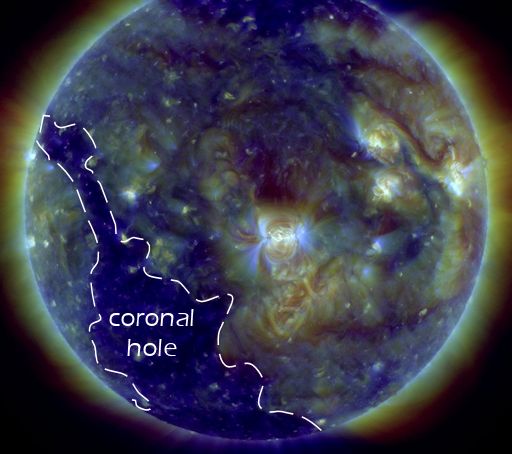
This is a "coronal hole"--a region where the sun's magnetic field has opened up, allowing solar wind to escape. A stream of solar wind emerging from this coronal hole could reach Earth as early as Dec. 7th and influence the near-space environment of our planet for several days. G1-class geomagnetic storms and high-latitude auroras are possible when the solar wind arrives. Note: The forecast will improve in the days ahead as the hole rotates into better view, revealing its form and dimensions. Stay tuned! Realtime Aurora Photo Gallery WATCH OUT FOR THE DA VINCI GLOW: If you go outside tonight to witness the meeting of Mars and the crescent Moon, pay special attention to the Moon. Cradled between the arms of the slender crescent is a display of light and shadow that puzzled sky watchers for thousands of years--until Leonardo da Vinci figured it out. It's the "Da Vinci glow," also known as Earthshine: 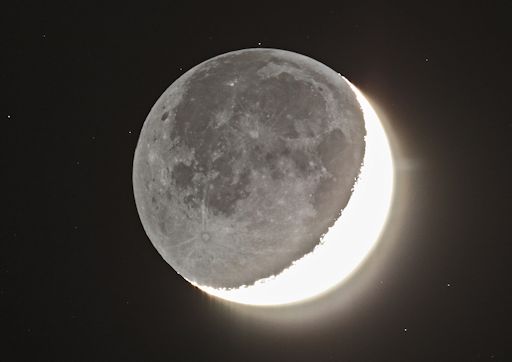
Jo Smeets of Itteren, the Netherlands, took the picture last night as the Moon was passing Venus en route to Mars. "The Earthshine really popped in this 5 second exposure with my Canon digital camera," says Smeets. For much of human history, people marveled at the faint image of the full Moon inside the arms of the bright crescent. Where did it come from? No one knew until the 16th century when Leonardo figured it out. He realized that dark lunar terrain was being illuminated by sunlight reflected from Earth. Visualizing this in the 1500s required a wild kind of imagination. No one had ever been to the Moon and looked "up" at Earth. Most people didn't even know that Earth orbited the sun. Copernicus' sun-centered theory of the solar system wasn't published until 1543, twenty-four years after Leonardo died. 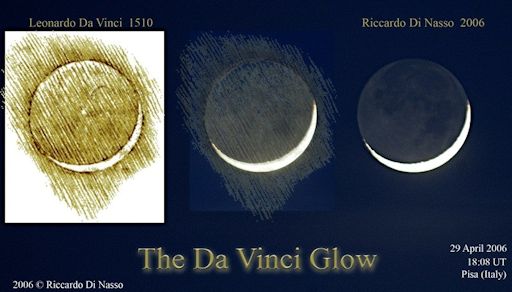
Above: Da Vinci's sketch of Earthshine in 1510 vs. Italian astronomer Riccardo Di Nasso's photo of Earthshine in 2006.
Wild imagination, however, was one thing Leonardo had in abundance. His notebooks are filled with sketches of flying machines, army tanks, scuba gear and other fantastic devices centuries ahead of their time. In Leonardo's Codex Leicester, circa 1510, there is a page entitled "Of the Moon: No Solid Body is Lighter than Air." He states his belief that the "ghostly glow" is due to sunlight bouncing off Earth's oceans and, in turn, hitting the Moon. 500 years later, we know that Earth's clouds (not oceans) do most of the reflecting; but that is a quibble. Leonardo understood the basics well enough. Go outside tonight and look to the sky. The Da Vinci Glow is waiting.... Realtime Space Weather Photo Gallery FLIGHT OF THE SPACE PICKLE: Did you know that cosmic radiation in Earth's atmosphere is increasing? It's true. These and other findings of the Earth to Sky Calculus ballooning program are funded not by government grants or corporate donations. Instead, we rely on crowdfunding. Hence, the flight of the space pickle: 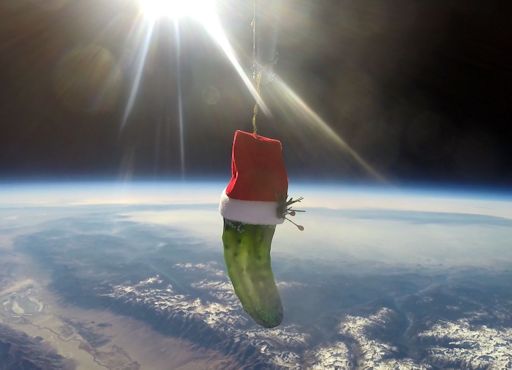
To raise funds for their ongoing research, Spaceweather.com and the students of Earth to Sky Calculus have flown a payload-full of Christmas pickles to the stratosphere. On Nov. 20th, the glass gherkins ascended to an altitude of 111,900 feet, experiencing temperatures as low as -55 C and cosmic ray dose rates more than 100x Earth normal. You can have one for your own tree. Price: $49.95. All proceeds are used to support cutting-edge student research. The space pickle and other edge of space gifts may be found in the Earth to Sky Store.
Realtime Sprite Photo Gallery
Realtime Airglow Photo Gallery Every night, a network of NASA all-sky cameras scans the skies above the United States for meteoritic fireballs. Automated software maintained by NASA's Meteoroid Environment Office calculates their orbits, velocity, penetration depth in Earth's atmosphere and many other characteristics. Daily results are presented here on Spaceweather.com. On Dec. 4, 2016, the network reported 13 fireballs.
(7 sporadics, 4 sigma Hydrids, 2 November omega Orionids)  In this diagram of the inner solar system, all of the fireball orbits intersect at a single point--Earth. The orbits are color-coded by velocity, from slow (red) to fast (blue). [Larger image] [movies] Potentially Hazardous Asteroids ( PHAs) are space rocks larger than approximately 100m that can come closer to Earth than 0.05 AU. None of the known PHAs is on a collision course with our planet, although astronomers are finding new ones all the time. On December 4, 2016 there were potentially hazardous asteroids. Notes: LD means "Lunar Distance." 1 LD = 384,401 km, the distance between Earth and the Moon. 1 LD also equals 0.00256 AU. MAG is the visual magnitude of the asteroid on the date of closest approach. | | Cosmic Rays in the Atmosphere |
Readers, thank you for your patience while we continue to develop this new section of Spaceweather.com. We've been working to streamline our data reduction, allowing us to post results from balloon flights much more rapidly, and we have developed a new data product, shown here: 
This plot displays radiation measurements not only in the stratosphere, but also at aviation altitudes. Dose rates are expessed as multiples of sea level. For instance, we see that boarding a plane that flies at 25,000 feet exposes passengers to dose rates ~10x higher than sea level. At 40,000 feet, the multiplier is closer to 50x. These measurements are made by our usual cosmic ray payload as it passes through aviation altitudes en route to the stratosphere over California. What is this all about? Approximately once a week, Spaceweather.com and the students of Earth to Sky Calculus fly space weather balloons to the stratosphere over California. These balloons are equipped with radiation sensors that detect cosmic rays, a surprisingly "down to Earth" form of space weather. Cosmic rays can seed clouds, trigger lightning, and penetrate commercial airplanes. Furthermore, there are studies ( #1, #2, #3, #4) linking cosmic rays with cardiac arrhythmias and sudden cardiac death in the general population. Our latest measurements show that cosmic rays are intensifying, with an increase of more than 12% since 2015: 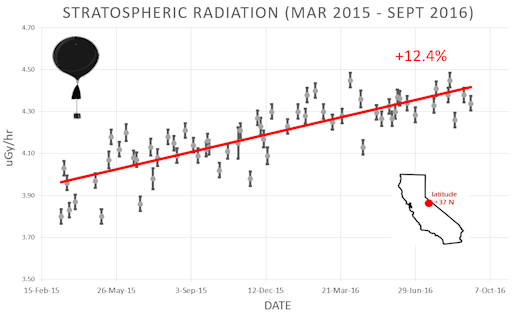
Why are cosmic rays intensifying? The main reason is the sun. Solar storm clouds such as coronal mass ejections (CMEs) sweep aside cosmic rays when they pass by Earth. During Solar Maximum, CMEs are abundant and cosmic rays are held at bay. Now, however, the solar cycle is swinging toward Solar Minimum, allowing cosmic rays to return. Another reason could be the weakening of Earth's magnetic field, which helps protect us from deep-space radiation. The radiation sensors onboard our helium balloons detect X-rays and gamma-rays in the energy range 10 keV to 20 MeV. These energies span the range of medical X-ray machines and airport security scanners. The data points in the graph above correspond to the peak of the Reneger-Pfotzer maximum, which lies about 67,000 feet above central California. When cosmic rays crash into Earth's atmosphere, they produce a spray of secondary particles that is most intense at the entrance to the stratosphere. Physicists Eric Reneger and Georg Pfotzer discovered the maximum using balloons in the 1930s and it is what we are measuring today. | | The official U.S. government space weather bureau | | | The first place to look for information about sundogs, pillars, rainbows and related phenomena. | | | Researchers call it a "Hubble for the sun." SDO is the most advanced solar observatory ever. | | | 3D views of the sun from NASA's Solar and Terrestrial Relations Observatory | | | Realtime and archival images of the Sun from SOHO. | | | from the NOAA Space Environment Center | | | a proud supporter of science education and Spaceweather.com | | | the underlying science of space weather | | | These links help Spaceweather.com stay online. Thank you to our supporters! | | 
